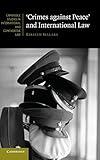"Crimes against peace" and international law / Kirsten Sellars.
By: Sellars, Kirsten.
Material type: BookSeries: Cambridge studies in international and comparative law.Publisher: UK : CUP, 2013Description: xv, 316 pages ; 24 cm.ISBN: 9781107028845.Subject(s): Crimes against peace -- History | Aggression (International law) -- History | International criminal law -- History | LAW / InternationalDDC classification: 341.62 Online resources: Contributor biographical information | Publisher description | Table of contents only
BookSeries: Cambridge studies in international and comparative law.Publisher: UK : CUP, 2013Description: xv, 316 pages ; 24 cm.ISBN: 9781107028845.Subject(s): Crimes against peace -- History | Aggression (International law) -- History | International criminal law -- History | LAW / InternationalDDC classification: 341.62 Online resources: Contributor biographical information | Publisher description | Table of contents only | Item type | Current location | Call number | Status | Date due | Barcode |
|---|---|---|---|---|---|
 Books
Books
|
Eastern University Library General Stacks | 341.62 SEC 2013 (Browse shelf) | Not For Loan | 14856 |
Includes bibliographical references (pages 294-305) and index.
Machine generated contents note: 1. The emergence of the concept of aggression; 2. The quest for control; 3. The creation of a crime; 4. Innovation and orthodoxy at Nuremberg; 5. The Allies and an ad hoc charge; 6. The elimination of militarism; 7. Questions of self-defence; 8. Divisions on the bench at Tokyo; 9. The uncertain legacy of crimes against peace; Postscript.
"In 1946, the judges at the International Military Tribunal at Nuremberg declared 'crimes against peace' - the planning, initiation or waging of aggressive wars - to be 'the supreme international crime'. At the time, the prosecuting powers heralded the charge as being a legal milestone, but it later proved to be an anomaly arising from the unique circumstances of the post-war period. This study traces the idea of criminalising aggression, from its origins after the First World War, through its high-water mark at the post-war tribunals at Nuremberg and Tokyo, to its abandonment during the Cold War. Today, a similar charge - the 'crime of aggression' - is being mooted at the International Criminal Court, so the ideas and debates that shaped the original charge of 'crimes against peace' assume new significance and offer valuable insights to lawyers, policy-makers and scholars engaged in international law and international relations"--


There are no comments for this item.